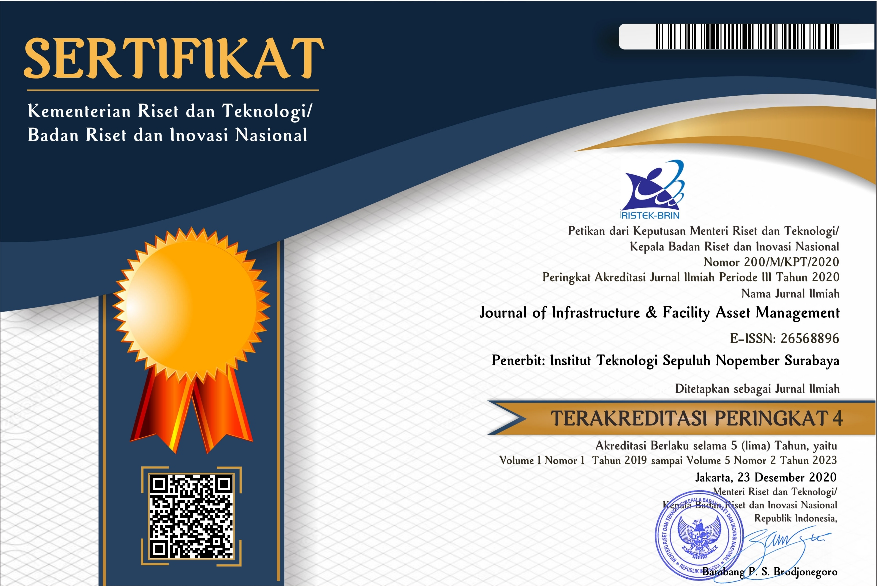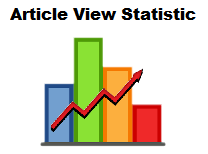Managing the Past into Future: Materiality and Discourse on Cultural Landscape
Abstract
Referring to the understanding of landscape as a cultural construct, the notion of the cultural landscape is constituted by its essential elements: system, people, and the landscape itself. The nexus between these elements was philosophically developed in a recent discourse that challenges the separation between cultural and natural heritage. This "segregation" is based originally on the hegemony of western values, in which cultural heritage resides mainly in monuments and sites; meanwhile, natural heritage is formed by the scientific idea of nature and wilderness as something isolated from people.
The landscape of Muara Muntai, a tiny settlement that has grown and developed on the riparian of Mahakam River, is characterized by the use of Ironwood or Eusideroxylon zwageri Teijsm (locally known as Kayu Ulin). This native plant of East Kalimantan is considered noteworthy, and in the perspective of ecology, is currently categorized as "threatened" due to deforestation in the last decades. For a couple of hundred years, locally-sourced Ironwood has been purposed and processed autonomously by the community as building and linkage-system material, creating a unique ambiance for Muara Muntai. The so-called modernization significantly changes the value of this native material: Ironwood building façades have been renovated into brick cement for the sake of practicality; Ironwood roads and bridges have been gradually paved with concrete to make way for motorized transportation.
Noting that the spirit of the place resides as much in the meaning and symbolism of place as it does in the locus settings, it requires a holistic approach to understand the conflict between modernization and place identity. The case of Muara Muntai will showcase how values of cultural heritage and its attributes -also to what extent the integrity, i.e. wholeness and intactness-will be able to be read and interpreted to give an overall sense of continuity.
Full Text:
PDFReferences
Andrus, P.W., Shrimpton, R.H. (2002). How to Evaluate the Integrity of a Property. U.S. Dept. of the Interior - National Parks Service, National Register, History and Education.
Anonymous. (1865). Aardrukskündig en Statistisch Woordenboek Van Nederlands en Indie. P. N. Van Kampen, Amsterdam.
Anonymous. (2017). Sejarah Kesultanan Kutai Kartanegara. (http://kesultanan.kutaikartanegara.com/index. php? menu=Sejarah; diakses 8/8/2017; 03:49 pm).
Anonymous.(2020). Borneo’s Deforestation.
https://wwf.panda.org/our_work/our_focus/forests_practice/deforestation_fronts2/deforestation_in_borneo_and_sumatra/ (acces: 29 Oct. 2020).
Effendi, R. (2009). “Kayu Ulin Di Kalimantan: Potensi, Manfaat, Permasalahan Dan Kebijakan Yang Diperlukan Untuk Kelestariannya (Eusideroxylon zwageri's Wood in Kalimantan: Potency, utilization, Problems and Needed policy for its Sustainability)”. Analisis Kebijakan Kehutanan, E-journal, Vol. 6, No. 3, 2009.
Jokilehto J., (2006). “Considerations on Authenticity and Integrity”. World Heritage Context City & Time 2 (1): 1. [online] URL:http://www.ct.ceci-br.org.
Kern, Dr. W.T., Venhage, 'S•Gra., Nijhoff, M. (1959). ‘Verhandelingen Van Het Koninklijk Instituut Voor Taal-, Land- en Volkenkunde Deel Xix Commentaar op de Salasilah van Koetai’, p. 112.
Kwanda, T. (2010). “Tradition of Conservation: Redefining Authenticity in Javanese Architectural Conservation”. Proceeding of Heritage 2010.2nd International Conference on Heritage and Sustainable Development, Evora, Portugal: 22-26 Juni.
Rhyne, C.S. (1995). The First International Document for Diverse Cultural Values in Conservation. The Document of Nara. American Institute for the Conservation of Historic and Artistic Works. St. Paul Minnesota.
Sari, F. Linda, R. Rusmiyanto, E. (2018). ”Pemanfaatan Tumbuhan yang Digunakan dalam Pembuatan Alat Musik Tradisional Khas Suku Dayak di Kota Pontianak dan Sekitarnya”. Protobiont (2018) Vol. 7 (2): 55–65 .
Schwab, K. (2017). The Fourth Industrial Revolution. New York: Crown Publishing Group
Smith, L. (2006). Uses of Heritage. New York: Routledge.
Stovel, H. (2007). “Effective use of authenticity and integrity as World Heritage qualifying conditions”. City & Time. vol. 2, Nr. 3.
Supena, J. et al. (2019). Kecamatan Muara Muntai Dalam Angka Tahun 2019. Badan Pusat Statistik Kabupaten Kutai Kartanegara.
Lennon, J.L. Taylor, K (eds.). (2012). Managing Cultural Landscapes. London: Routledge.
Martokusumo, W. (2019). “Heritage and Sustainable Urban Design: Extending the Role of Heritage Conservation in Urban Design”. Paper presented at the 1st International Conference on Urban Design and Planning, University Diponegoro, 10 September.
Veldpaus, L., Pereira -Roders, A., Colenbrander, B.J. F. (2013). “Urban Heritage: Putting the Past into the Future”. The Historic Environment. Vol. 4 No. 1, April, pp. 3–18
Weiler, K., Gutschow, N. (eds.). (2017). Authenticity in Architectural Heritage Conservation: Discourse, Opinions, Experiences in Europe. South and East Asia. Heildelberg: Springer.
Wells, J. (2010). Valuing Historic Places: Traditional and Contemporary Approaches, School of Architecture, Art, and Historic Preservation Faculty Papers. Paper 22.
Government Regulation
UU 11/10. Undang-Undang Republik Indonesia Nomor 11 Tahun 2010 tentang Cagar Budaya (Laws of Republik Indonesia Number 11 of 2010 on Cultural Heritage).
Interviews
Aji Djon, (2019). “Interview. Local residents and relatives of the Kutai Kartanegara” in Martadipura Sultanate.
Arifin, YR. (2020). “Interview via telephone and whatsapp communication”. Wood researcher at Forestry of Papua University & academic resource persons.
Asmara, A, (2020). “Interview via telephone”. Retirement of Cultural Office Kutai Kartanegara District & local resident.
Gelollw, M. (2020). “Interview via telephone and social media”. Resource persons for cultural actors.
Jaini, M. (2020). “Interview via telephone”. Retirement of Cultural Office Kutai Kartanegara District & former local resident.
Pudjowati, P. (2020). “Interview via zoom.us”. Academic resource persons and researchers at Agricultural Faculty of Mulawarman University.
Rahman, I. (2020). “Interview via zoom.us”. Tourist resource person, Chairman of the Indonesian Tour Guides Association DPC Kutai Kartanegara.
Saleh. (2020). “Interview via telephone”. Muara Muntai Sub-district office employee & local resident.
Survey KSPN. (2016)
DOI: http://dx.doi.org/10.12962%2Fjifam.v4i1.14301
Refbacks
- There are currently no refbacks.
Visitor :
Flag Counter

Journal Of Infrastructure & Facility Asset Management by Institut Teknologi Sepuluh Nopember is licensed under a Creative Commons Attribution-ShareAlike 4.0 International License.





